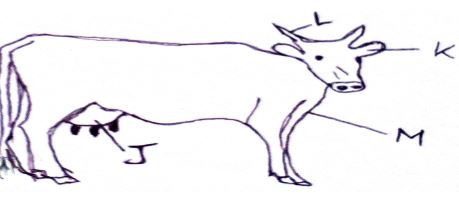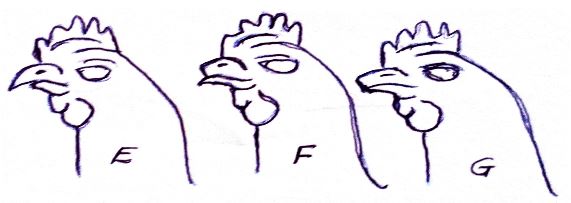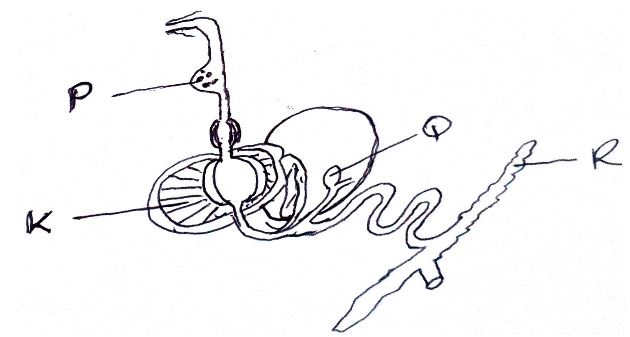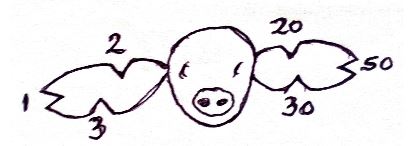SECTION A: (30 MARKS)
- State four factors that affect quality of honey. (2 mks)
- State four adaptive characteristics of goats to arid and semi-arid areas. (2 mks)
- List two methods used in computation of feed rations. (1 mk)
- Distinguish between apiculture and aquaculture. (2 mks)
- List four advantages of using concrete as a construction material. (4 mks)
- Mention four symptoms observed on livestock attacked by roundworms. (2 mks)
- What is the functional differences between hack saw and pruning saw. (1 mk)
- Give the correct name of the breeding system outlined below. (2 mks)
- Breeding of very closely related animals –
- Breeding of two unrelated animals within the same breed –
- Mating of distantly related animals that share a common ancestor –
- Breeding of unrelated animals belonging to different breeds –
- State two roles of micro-organisms found in the rumen in ruminant animals. (2 mks)
- Mention two livestock rearing practices that make animals docile. (1 mk)
- Name the camel breed that is adapted to cooler regions. (1 mk)
- Name three species of farm animals that are affected by louse. (1 ½ mks)
- Complete the table below (2 mks)
Animal Parturition term Gestation period Goats Rabbits Pigs Cattle - Mention one distinguishing external feature of the following livestock breeds:- (2 mks)
- Bactrian camel –
- Large white pig –
- Dorper sheep –
- Galloway breed of cattle –
- Identify three areas infested with a three-host tick on a Boran bull. (1 ½ mks)
- State four reasons for maintaining livestock tools. (2 mks)
- What four conditions that may lead to culling of a breeding boar. (2 mks)
- Identify two practices carried out to increase timber durability. (1 mk)
SECTION B: (20 MARKS)
Answer all the questions from this section.
- Study the diagram below and answer the questions that follow.
- Identify a disease that is likely to affect the part labeled J. (1 mk)
- Name two operations that can be carried out on the part labeled K. (2 mks)
- Name one tool used to carry out the operation on the part labeled L. (1 mk)
- Name the part labeled M. (1 mk)
- The illustrations below show three different ways some hens are debeaked.
- Which of the hens E, F, and G was correctly debeaked? (1 mk)
- Give a reason for your answer in (a) above. (1 mk)
- Apart from debeaking, give three other ways of controlling egg-eating in a flock of layers. (3 mks)
- The diagram below illustrates digestive system of a hen.
- Name the parts labeled P, Q and R. (3 mks)
P ……………………………….. Q …………………………. R ………………………… - State two features of part K to its function. (2 mks)
- Name the parts labeled P, Q and R. (3 mks)
- Study the diagram below and answer the questions that follow.
- Name the practice shown above. (1 mk)
- State the method illustrated above. (1 mk)
- Give the identification number of the pig illustrated above. (1 mk)
- Using a diagram, illustrate how animal number 83 can be drawn. (2 mks)
SECTION C:
Answer any two questions from this section.
-
- Discuss ten factors considered when selecting a breeding stock. (10 mks)
- State and explain five pre-disposing factors of livestock diseases. (10 mks)
-
- State and explain the functions of five complimentary farm tools and equipment. (10 mks)
- Discuss five factors that determine the amount of water taken by an animal. (10 mks)
-
- Discuss five structural requirements of a calf pen. (10 mks)
- State ten general characteristics of exotic beef cattle breeds . (10 mks)
MARKING SCHEME
SECTION A: (30 MARKS)
- State four factors that affect quality of honey. (2 mks)
- Age/maturity of honey
- Method of harvesting
- Method of processing
- Type of plants from where nectar was sourced
- State four adaptive characteristics of goats to arid and semi-arid areas. (2 mks)
- Feed on wide range of vegetation
- Require little amount of water
- Are tolerant to high temperatures
- Are fairly resistant to diseases
- Walk long distances without losing weight.
- List two methods used in computation of feed rations. (1 mk)
- Trial and error
- Using Pearson’s square method
- Distinguish between apiculture and aquaculture. (2 mks)
- Apiculture: Bee keeping
- Aquaculture, Rearing fish in fish pond.
- List four advantages of using concrete as a construction material. (4 mks)
- Strong and durable
- Resistant to fire
- Resistant to insect damage
- Resistant to rotting and weather elements
- Easy to clean
- Can be moulded into various shapes
- Mention four symptoms observed on livestock attacked by roundworms. (2 mks)
- Dry/starring coat
- Emaciation
- Diarrhoea
- Anaemia
- Anorexia
- Pot-bellies in young animals
- What is the functional differences between hack saw and pruning saw. (1 mk)
- Hack saw – Cutting metal rods and plates
- Pruning saw: - Cutting hard branches
- Give the correct name of the breeding system outlined below. (2 mks)
- Breeding of very closely related animals – Close breeding
- Breeding of two unrelated animals within the same breed – Out crossing
- Mating of distantly related animals that share a common ancestor – Line breeding
- Breeding of unrelated animals belong to different animals – Cross breeding
- State two roles of micro-organisms found in the rumen in ruminant animals. (2 mks)
- Some synthesise amino acids
- Secrete cellulose that breakdown cellulose
- Some help in synthesis of Vitamin B complex and K.
- Mention two livestock rearing practices that make animals docile. (1 mk)
- Dehorning
- Castration/caponization
- Name the camel breed that is adapted to cooler regions. (1 mk)
- Bactrian
- Name three species of farm animals that are affected by louse. (1 ½ mks)
- Sheep
- Poultry
- Bees
- Complete the table below (2 mks)
Animal Parturition term Gestation period Goats Kidding 150 days Rabbits Kindling 28-32 days Pigs Farrowing 113-117 days Cattle Calving 270 – 285 days - Mention one distinguishing external feature of the following livestock breeds:- (2 mks)
- Bactrian camel – Have two humps; body covered with fur
- Large white pig – Blue spots on the body
- Dorper sheep – Black head – white body
- Galloway breed of cattle – Long black hair with brown tinge
- Identify three areas infested with a three-host tick on a Boran bull. (1 ½ mks)
- Ears
- Udder
- Tail switch
- State four reasons for maintaining livestock tools. (2 mks)
- To increase durability
- To reduce replacement cost
- To increase efficiency
- To avoid injury to user
- To avoid damage to the tool
- What four conditions that may lead to culling of a breeding boar. (2 mks)
- Low libido/fertility
- Overweight
- Serious physical injury
- Old age
- Infection from Chronic disease
- Need to control breeding
- Identify two practices carried out to increase timber durability. (1 mk)
- Seasoning
- Chemical treatment
SECTION B: (20 MARKS)
Answer all the questions from this section.
- Study the diagram below and answer the questions that follow.
- Identify a disease that is likely to affect the part labeled J. (1 mk)
- Mastitis
- Name two operations that can be carried out on the part labeled K. (2 mks)
- Ear notching
- Ear tagging
- Ear tatooing
- Name one tool used to carry out the operation on the part labeled L. (1 mk)
- Dehorning saw/wire
- Rubber ring and elastrator
- Name the part labeled M. (1 mk)
- Dewlap
- Identify a disease that is likely to affect the part labeled J. (1 mk)
- The illustrations below show three different ways some hens are debeaked.
- Which of the hens E, F, K ,L and G was correctly debeaked? (1 mk)
- F
- Give a reason for your answer in (a) above. (1 mk)
- Upper beak used for pecking others/objects/eggs
- Apart from debeaking, give three other ways of controlling egg-eating in a flock of layers. (3 mks)
- Collect eggs regularly
- Supply green leaves to keep birds busy
- Cull perpetual egg eaters
- Which of the hens E, F, K ,L and G was correctly debeaked? (1 mk)
- The diagram below illustrates digestive system of a hen.
- Name the parts labeled P, Q and R. (3 mks)
P – Crop Q – Gall bladder R- Caecum - State two features of part K to its function. (2 mks)
- Tough muscles
- Presence of grit(sand)
- Ridged on the inside
- Name the parts labeled P, Q and R. (3 mks)
- Study the diagram below and answer the questions that follow.
- Name the practice shown above. (1 mk)
- Identification
- State the method illustrated above. (1 mk)
- Ear notching
- Give the identification number of the pig illustrated above. (1 mk)
- 106
- Using a diagram, illustrate how animal number 83 can be drawn. (2 mks)
- Name the practice shown above. (1 mk)
SECTION C:
Answer any two questions from this section.
-
- Discuss ten factors considered when selecting a breeding stock. (10 mks)
- Age: – Young animals (those that have parturated for not more them three times) should be selected.
- Prolificacy: - Animals with ability to give birth to many off-springs at a time should be selected.
- Level of performance: - animals with the highest production level are considered
- Physical fitness: - Selected animals should be free from any physical defects e.g. limp limping, scrotal hernia among others.
- Adaptability: - Selected animals should cope well to the prevailing climatic conditions in the area.
- Temperament or behavior:- Selected animals should not show undesirable behavior e.g. kicking in dairy cattle.
- Mothering ability: - Animals selected should have good natural instinct towards their young ones.
- Health: Animals selected must be healthy
- Body conformation: - Animals selected should have proper body shape as per the type e.g. wedge for dairy cattle.
- Quality of products: Selected animals should give products of high quality.
(1 x 10)
- State and explain five pre-disposing factors of livestock diseases. (10 mks)
- Sex of the animal: Certain diseases only attack male or female animals due to their different organs e.g. orchitis only attack males.
Age of the animal: Certain diseases only affect animals of a certain age group e.g. pneumonia in calves - Colour of the animal: Body colour can pre-dispose an animal e.g. heat stress in black animals or photosensitization in light pigmented skins.
- Species of the animal: some diseases affect certain species of animals e.g. Newcastle in poultry.
- Breed of the animal: Certain breeds of animals get affected by certain diseases e.g. Cancer of the eye affecting Hereford breed of cattle.
(2 x 5)
- Sex of the animal: Certain diseases only attack male or female animals due to their different organs e.g. orchitis only attack males.
- Discuss ten factors considered when selecting a breeding stock. (10 mks)
-
- State any explain the functions of five complimentary farm tools and equipment. (10 mks)
- Elastrator and rubber ring: Expanding the rubber ring while castrating, docking or dehorning.
- Hypodermic needle and syringe: Injecting medicine/vaccine into animals as well as extracting blood samples for analysis.
- Bull ring and lead stick: Restraining bulls and oxen.
- Trocar and canula: - Removal of gases which cause bloat in ruminants.
- Bit and brace: - Holding and turning wood bits to bore holes in the wood.
- Ball pair hammer and cold chisel: Striking the head of cold chisel during cutting of thick sheets of metal.
(2 x 5)
- Discuss five factors that determine the amount of water taken by an animal. (10 mks)
- Ambient temperature: - animals need more water when it is hot due to high rate of sweating
- Type of feed eaten: - animals drink a lot after consuming dry feeds then when they eat succulent feeds.
- Level of production: animals producing milk or eggs require more water. Draught animals need more water due to sweating.
- Weight/body size of the animal: Fat and heavy animals require more water than lean0 and light animals.
- Species of the animals: Cattle for example can need more water than camels under same environmental conditions.
(2 x 5)
- State any explain the functions of five complimentary farm tools and equipment. (10 mks)
-
- Discuss five structural requirements of a calf pen. (10 mks)
- Concrete floors: - It makes cleaning easy.
- Adequate space: - Should be large enough to allow exercise, feeding and watering equipment.
- Single housing: Should only allow one calf per pen.
- Proper lighting: - Should allow enough lights which is necessary for synthesis of vitamin D.
- Proper drainage: - The area should be well drained to prevent dampness which can pre-dispose the calf to infections.
- Draught free: - The pen should not allow in cold wind; as it pre-disposes calf to pneumonia.
- Leak proof roof: The roof should not allow water in to avoid wellness in the pen.
(2 x 5)
- State ten general characteristics of exotic beef cattle breeds . (10 mks)
- Blocky in shape/appear square/rectangular.
- Have deep well fleshed bodies.
- Grow fast leading to early maturity.
- Efficient converters of food into meat and fat.
- Are good foragers/have reduced selective grazing.
- Maintain good weight even during drought.
- Are tolerant to high temperatures.
- They breed regularly
- More tolerant to diseases
- Have short stray legs.
- Discuss five structural requirements of a calf pen. (10 mks)
Download Agriculture Paper 2 Questions and Answers - Form 3 Term 3 Opener Exams 2023.
Tap Here to Download for 50/-
Get on WhatsApp for 50/-
Why download?
- ✔ To read offline at any time.
- ✔ To Print at your convenience
- ✔ Share Easily with Friends / Students






